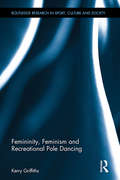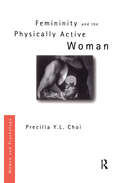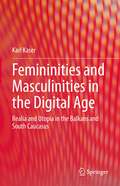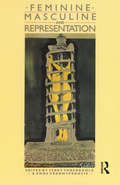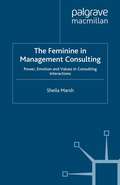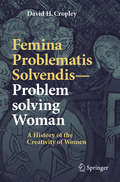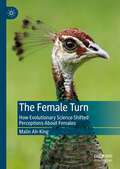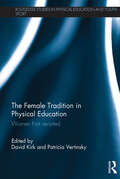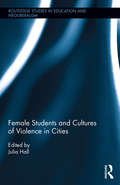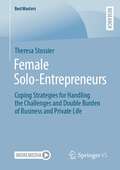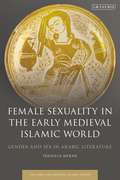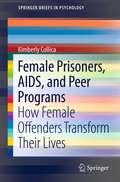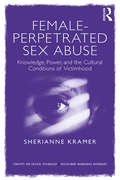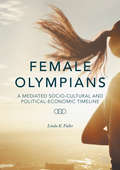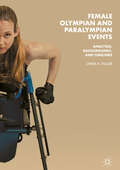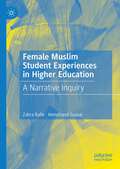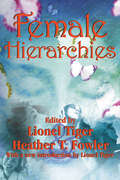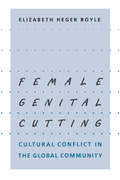- Table View
- List View
Femininity, Feminism and Recreational Pole Dancing (Routledge Research in Sport, Culture and Society)
by Kerry GriffithsThis book explores the phenomenon of pole dancing as an increasingly popular fitness and leisure activity for women. It moves beyond previous debates surrounding the empowering or degrading nature of pole dancing classes, and instead explores the complexities of these concepts and highlights that women participating in this practice cannot be seen as one dimensional. Femininity, Feminism and Recreational Pole Dancing explores the construction, negotiation and presentation of a gendered and classed identity and self through participation in pole dancing, the meaning of pole dancing as a fitness practice for women, and the concepts of community and friendship as developed through classes. Using empirical research, the book uncovers the stories and experiences of the women who participate in these classes, and examines what the mainstreaming of this type of sexualised dance means for the women who practice it. Pole dancing is shown to be a practice in which female identities are negotiated, performed and enacted and this book positions pole dancing as an activity which both reinforces but also presents some challenge to ideas of feminism and femininity for the women that participate. Women's participation in pole dancing is described in a discourse of choice and control, yet this book argues that the decision to participate is somewhat constructed by the advertising of these classes as enabling women to create a particular desirable self, which is perpetuated throughout our culture as the ‘ideal’. Exploring the ways in which women attempt to manage impressions and present themselves as ‘respectable’, the book examines how women wish to dis-identify with both women who work as strippers and women who are feminist, seeing both identities as contradictory to the feminine image that they pursue. The book explores the capacity of these classes to offer women some feelings of agency but challenges the idea that participating in pole dancing can offer collective empowerment. The book ultimately argues that women’s participation can be viewed both in terms of their active engagement and enjoyment of these classes and in terms of the structures and pressures which continue to shape their lives. This timely publication explores the complexity of the pole dancing phenomenon and highlights a range of questions surrounding this activity as a leisure form. It will be a valuable contribution to those interested in women’s and gender studies, cultural studies, feminism, sociology and leisure studies.
Femininity and the Physically Active Woman (Women And Psychology Ser.)
by Precilla Y. ChoiThe fitness boom of the last two decades has led to many people incorporating exercise into their lifestyles through activities such as jogging and aerobics. However, whilst many physical and psychological health benefits have been documented, far too few people actually take part in enough exercise to glean significant improvements, and this is much more a problem for women than men.Femininity and the Physically Active Woman explores one reason many women offer for their lack of involvement in sport and exercise - that they are not the 'sporty' type. Precilla Y.L. Choi argues that the 'sporty' type is masculine, and to determine how this notion might affect women's self-perceptions, she critically examines the experiences of women athletes, bodybuilders, recreational exercisers and girls' physical education. What emerges is the importance of visible differences between women and men, in terms of muscularity, strength and agility in order to maintain the gender order. Thus, if a girl or woman wishes to play the masculine game of sport she must do so in conformity with a number of patriarchal rules which ensure she is first and foremost recognised as a heterosexual feminine being.Contributing to a psychology of the physically active woman by examining women's experiences from critical feminist and gendered perspectives, Femininity and the Physically Active Woman will be of great interest to students, researchers, practitioners and teachers from a range of disciplines.Precilla Y.L. Choi is the British Association for the Advancement of Science's Joseph Lister Lecturer for 2000. She has co-edited, with Paula Nicolson, Female Sexuality (Prentice Hall).
Femininity and the Physically Active Woman (Women And Psychology Ser.)
by Precilla Y. ChoiThe fitness boom of the last two decades has led to many people incorporating exercise into their lifestyles through activities such as jogging and aerobics. However, whilst many physical and psychological health benefits have been documented, far too few people actually take part in enough exercise to glean significant improvements, and this is much more a problem for women than men.Femininity and the Physically Active Woman explores one reason many women offer for their lack of involvement in sport and exercise - that they are not the 'sporty' type. Precilla Y.L. Choi argues that the 'sporty' type is masculine, and to determine how this notion might affect women's self-perceptions, she critically examines the experiences of women athletes, bodybuilders, recreational exercisers and girls' physical education. What emerges is the importance of visible differences between women and men, in terms of muscularity, strength and agility in order to maintain the gender order. Thus, if a girl or woman wishes to play the masculine game of sport she must do so in conformity with a number of patriarchal rules which ensure she is first and foremost recognised as a heterosexual feminine being.Contributing to a psychology of the physically active woman by examining women's experiences from critical feminist and gendered perspectives, Femininity and the Physically Active Woman will be of great interest to students, researchers, practitioners and teachers from a range of disciplines.Precilla Y.L. Choi is the British Association for the Advancement of Science's Joseph Lister Lecturer for 2000. She has co-edited, with Paula Nicolson, Female Sexuality (Prentice Hall).
Femininities and Masculinities in the Digital Age: Realia and Utopia in the Balkans and South Caucasus
by Karl KaserThis book provides a fresh overview on the debate about the remarkable regression of gender equality in the Balkans and South Caucasus caused by the fall of socialism and by the revitalization of religion in Turkey. Contrary to the prevailing opinion of researchers who state continuous male domination, the book presents strong arguments for an alternative outlook. By contrasting the realia of gender relations with the utopia of new femininities and new masculinities driven by digital visual communication, the book provokingly concludes with the arrival of two utopias: the Marlboro Man – still authoritative but lonely – conquering and refusing family obligations; and with the emergence of a new femininity type – strong and beautiful. As such this book provides a great resource to anthropologists, demographers, sociologists, gender and media researchers and all those interested in feminist issues.
Feminine/Masculine and Representation
by Terry Threadgold Anne Cranny-FrancisFeminine/Masculine and Representation provides a much needed introduction to a number of challenging issues raised in debates within gender studies, critical theory and cultural studies. In analysing cultural processes using a range of different methods, the essays in this collection focus on gender/sexuality, representation and cultural politics across a variety of media.
Feminine/Masculine and Representation
by Terry Threadgold Anne Cranny-FrancisFeminine/Masculine and Representation provides a much needed introduction to a number of challenging issues raised in debates within gender studies, critical theory and cultural studies. In analysing cultural processes using a range of different methods, the essays in this collection focus on gender/sexuality, representation and cultural politics across a variety of media.
The Feminine in Management Consulting: Power, Emotion and Values in Consulting Interactions
by S. MarshThrough 'live' material from consulting practice and an historical review of advice-giving to pre-modern leaders, this book uncovers a distinctive 'feminine' discourse of management consulting. This new lens challenges current literature on management consulting that relies on established (masculine) images.
Femina Problematis Solvendis—Problem solving Woman: A History of the Creativity of Women
by David H. CropleyThis book explores the history of modern human creativity/innovation, highlighting examples of solutions to basic human’ needs that have been developed over time. The title – Femina Problematis Solvendis – is a play on the scientific classifications of humans (Homo habilis, Homo erectus, Homo sapiens), but with special focus on inventions pioneered by women (“femina”) and is intended to suggest that a defining characteristic of modern humans is our fundamental ability to solve problems (i.e., problem-solving woman = Femina problematis solvendis), Written by David H. Cropley, an internationally recognised expert on creativity and innovation, it also builds on his previous book “Homo Problematis Solvendis –Problem-solving Man”, published in 2019. The book explores innovations over ten distinct “ages” of human history, beginning with “prehistory”, and moving up to the present “information age”. Each era is covered by a dedicated chapter that describes three key innovations that were either definitely invented by a woman or can be plausibly attributed to a female inventor. The book’s focus on female inventors also serves to highlight some of the ways women have been treated in societies over time.
The Female Turn: How Evolutionary Science Shifted Perceptions About Females
by Malin Ah-KingThis book traces the history of how evolutionary biology transformed its understanding of females from being coy, reserved and sexually passive, to having active sexual strategies and often mating with multiple males. Why did it take so long to discover female active sexual strategies? What prevented some researchers from engaging in sexually active females, and what prompted others to develop this new knowledge? The Female Turn provides a global overview of shifting perceptions about females in sexual selection research on a wide range of animals, from invertebrates to primates. Evolutionary biologist and feminist science scholar Malin Ah-King explores this history from a unique interdisciplinary vantage point. Based on extensive knowledge of the scientific literature on sexual selection and in-depth interviews with leading researchers, pioneers and feminist scientists in the field, her analysis engages with key theoretical approaches in gender studies of science. Analyzing the researchers’ scientific interests, theoretical frameworks, specific study animals, technological innovations, methodologies and sometimes feminist insights, reveals how these have shaped conclusions drawn about sex. Thereby, The Female Turn shows how certain researchers gained knowledge about active females whereas others missed, ignored or delayed it – that is, how ignorance was produced.
The Female Tradition in Physical Education: Women First reconsidered (Routledge Studies in Physical Education and Youth Sport)
by David Kirk and Patricia VertinskyThe Female Tradition in Physical Education re-examines a key question in the history of modern education: why did the remarkably successful leaders of female physical education, who pioneered the development of the subject in late nineteenth- and early twentieth-century England, Canada, Australia and New Zealand, lose control in the years following the Second World War? Despite the later resurgence of second wave feminism they never regained a voice, with the result that male leadership was able to shift the curriculum in ways that neglected the needs and interests of girls and young women. Drawing on new sources and a range of historiographical approaches, and touching on related fields such as therapeutic exercise and dance, the book examines the development of physical education for girls in a number of countries to offer an alternative explanation to the dominant narrative of the ‘demise’ of the female tradition. Providing an important contextualization for the state of contemporary female physical education, this is fascinating reading for anybody with an interest in the development of sport and physical education, women’s and gender history, and physical culture more generally.
The Female Tradition in Physical Education: Women First reconsidered (Routledge Studies in Physical Education and Youth Sport)
by David Kirk Patricia VertinskyThe Female Tradition in Physical Education re-examines a key question in the history of modern education: why did the remarkably successful leaders of female physical education, who pioneered the development of the subject in late nineteenth- and early twentieth-century England, Canada, Australia and New Zealand, lose control in the years following the Second World War? Despite the later resurgence of second wave feminism they never regained a voice, with the result that male leadership was able to shift the curriculum in ways that neglected the needs and interests of girls and young women. Drawing on new sources and a range of historiographical approaches, and touching on related fields such as therapeutic exercise and dance, the book examines the development of physical education for girls in a number of countries to offer an alternative explanation to the dominant narrative of the ‘demise’ of the female tradition. Providing an important contextualization for the state of contemporary female physical education, this is fascinating reading for anybody with an interest in the development of sport and physical education, women’s and gender history, and physical culture more generally.
Female Students and Cultures of Violence in Cities (Routledge Studies in Education, Neoliberalism, and Marxism)
by Julia HallAs the economy constricts, it seems living with a chronic sense of fear and anxiety is the new normal for a growing number of urban females. Many females are susceptible to victimization by cumulative strands of violence in school, their communities, families and partnerships. Exposure to violence has been shown to contribute to physical and mental health problems, a propensity for substance abuse, transience and homelessness, and unsurprisingly, poor school attendance and performance. What does a girl do when there is no place to get away from this, and even school is a danger zone? Why have so many educators turned their attention away from the reality of violence against girls? Why is there a tendency to categorize such violence as just another example of the general concept of "bullying?" Critical educators who research the effects of current market logics on the schooling of marginalized youth have yet fully to focus on this issue. This volume puts the reality of violence in the lives of urban school girls back on the map, investigates answers to the above questions, and presents suggestions for change.
Female Students and Cultures of Violence in Cities (Routledge Studies in Education, Neoliberalism, and Marxism #9)
by Julia HallAs the economy constricts, it seems living with a chronic sense of fear and anxiety is the new normal for a growing number of urban females. Many females are susceptible to victimization by cumulative strands of violence in school, their communities, families and partnerships. Exposure to violence has been shown to contribute to physical and mental health problems, a propensity for substance abuse, transience and homelessness, and unsurprisingly, poor school attendance and performance. What does a girl do when there is no place to get away from this, and even school is a danger zone? Why have so many educators turned their attention away from the reality of violence against girls? Why is there a tendency to categorize such violence as just another example of the general concept of "bullying?" Critical educators who research the effects of current market logics on the schooling of marginalized youth have yet fully to focus on this issue. This volume puts the reality of violence in the lives of urban school girls back on the map, investigates answers to the above questions, and presents suggestions for change.
Female Solo-Entrepreneurs: Coping Strategies for Handling the Challenges and Double Burden of Business and Private Life (BestMasters)
by Theresa StossierAustria’s economy is characterized through small and medium sized enterprises. Solo entrepreneurs are considered a special form within SMEs and contribute a major share to Austrian’s economy besides being Austria’s most popular legal form of organization within the micro firms. In 2020 every second of Carinthia’s start-up businesses was established by a female entrepreneur. According to an entrepreneurship study presented by Volksbank in 2019, nearly half of all female entrepreneurs lived with children and juveniles. Two-thirds of women said they were solely responsible for family, childcare, and household and 71 percent of those female entrepreneurs specified that those circumstances caused difficulties for them. This book investigated Carinthian female solo entrepreneurs and aims to find out how these hard-working women manage their business and private life while contributing to such great extent to the (federal) state’s economy. The conceptual foundations were found in embeddedness and the contextual framework which supports the importance of numerous influences on different levels placed on the entrepreneur. The empirical section represents a primary research that evaluates self-collected data sets of Carinthian solo-entrepreneurs.
Female Sexuality in the Early Medieval Islamic World: Gender and Sex in Arabic Literature (Early and Medieval Islamic World)
by Pernilla MyrneIn the early Islamic world, Arabic erotic compendia and sex manuals were a popular literary genre. Although primarily written by male authors, the erotic publications from this era often emphasised the sexual needs of women and the importance of female romantic fulfilment. Pernilla Myrne here explores this phenomenon, examining a range of Arabic literature to shed fresh light onto the complexities of female sexuality under the Abbasids and the Buyids. Based on an impressive array of neglected medical, religious-legal, literary and entertainment sources, Myrne elucidates the tension between depictions of women's strong sexual agency and their subordinated social role in various contexts. In the process she uncovers a great diversity of approaches from the 9th to the 11th century, including the sexual handbook the Encyclopedia of Pleasure (Jawami' al-ladhdha), which portrayed the diversity of female desires, asserting the importance of mutual satisfaction through lively poems and stories. This is the first in-depth, comprehensive analysis of female sexuality in the early Islamic world and is essential reading for all scholars of Middle Eastern history and Arabic literature.
Female Sexuality in the Early Medieval Islamic World: Gender and Sex in Arabic Literature (Early and Medieval Islamic World)
by Pernilla MyrneIn the early Islamic world, Arabic erotic compendia and sex manuals were a popular literary genre. Although primarily written by male authors, the erotic publications from this era often emphasised the sexual needs of women and the importance of female romantic fulfilment. Pernilla Myrne here explores this phenomenon, examining a range of Arabic literature to shed fresh light onto the complexities of female sexuality under the Abbasids and the Buyids. Based on an impressive array of neglected medical, religious-legal, literary and entertainment sources, Myrne elucidates the tension between depictions of women's strong sexual agency and their subordinated social role in various contexts. In the process she uncovers a great diversity of approaches from the 9th to the 11th century, including the sexual handbook the Encyclopedia of Pleasure (Jawami' al-ladhdha), which portrayed the diversity of female desires, asserting the importance of mutual satisfaction through lively poems and stories. This is the first in-depth, comprehensive analysis of female sexuality in the early Islamic world and is essential reading for all scholars of Middle Eastern history and Arabic literature.
Female Prisoners, AIDS, and Peer Programs: How Female Offenders Transform Their Lives (SpringerBriefs in Psychology)
by Kimberly Collica This book highlights a neglected area in the field of rehabilitation of female offenders with AIDS. It provides data to show how women, working as HIV peer educators in prison, utilize their peer experiences as a transition point for rehabilitation both inside and outside of the penitentiary. HIV and prison are inextricably linked and education has proved to be the one constant that mitigates the spread of both HIV and crime. Research on female inmates in general is not frequent and this book presents unique qualitative data that includes rich accounts from the women themselves. It illustrates the benefits derived by female inmates who work in an HIV prison-based peer program, while adding to the criminology literature on female patterns of criminality and rehabilitation. It provides a greater understanding of how prison programs affect the processes of criminal desistance and behavioral changes for female inmates. Women involved in such programming are able to change the criminal trajectory of their life direction. contributing to reduced levels of recidivism and institutional disciplinary infractions. The implications for these programs is relevant within the broader perspective of women, HIV and incarceration.
Female-Perpetrated Sex Abuse: Knowledge, Power, and the Cultural Conditions of Victimhood (Concepts for Critical Psychology)
by Sherianne KramerFemale-Perpetrated Sex Abuse is a groundbreaking study into gender, sexuality and victimhood. It examines the cultural conditions of possibility for FSA victimhood as a means to advance contemporary critical understandings of the role of gender and sexuality as instruments of modern power. As the first direct exploration of FSA victimhood, this book analyses: why victims of FSA remain so underexplored and invisible as objects of human science knowledge; the limited and overly rigid discourses in local and global psychological theory and practice that continues to treat particular subjects as ‘victim worthy’ through paradigms that construct victimhood as gendered; and the possibility of new discourses that could disrupt normative understandings of gender, sexuality, and power in sex abuse, and as constitutive to the beginnings of a counter-knowledge on transgressive sexualities. By tracing the historical and cultural conditions of the emergence of FSA broadly and FSA victimhood specifically, Kramer illustrates how deeply engrained constructions of gender and sexuality both produce and constrain the possibilities for reporting, disclosing and self-identifying victimhood. Female-Perpetrated Sex Abuse is essential reading for academics, researchers and students alike, in the areas of psychology, sociology, gender studies, criminology, counselling and social work.
Female-Perpetrated Sex Abuse: Knowledge, Power, and the Cultural Conditions of Victimhood (Concepts for Critical Psychology)
by Sherianne KramerFemale-Perpetrated Sex Abuse is a groundbreaking study into gender, sexuality and victimhood. It examines the cultural conditions of possibility for FSA victimhood as a means to advance contemporary critical understandings of the role of gender and sexuality as instruments of modern power. As the first direct exploration of FSA victimhood, this book analyses: why victims of FSA remain so underexplored and invisible as objects of human science knowledge; the limited and overly rigid discourses in local and global psychological theory and practice that continues to treat particular subjects as ‘victim worthy’ through paradigms that construct victimhood as gendered; and the possibility of new discourses that could disrupt normative understandings of gender, sexuality, and power in sex abuse, and as constitutive to the beginnings of a counter-knowledge on transgressive sexualities. By tracing the historical and cultural conditions of the emergence of FSA broadly and FSA victimhood specifically, Kramer illustrates how deeply engrained constructions of gender and sexuality both produce and constrain the possibilities for reporting, disclosing and self-identifying victimhood. Female-Perpetrated Sex Abuse is essential reading for academics, researchers and students alike, in the areas of psychology, sociology, gender studies, criminology, counselling and social work.
Female Olympians: A Mediated Socio-Cultural and Political-Economic Timeline
by Linda K. FullerThis book examines women's participation in the Olympic Games since they were allowed to be included in that global arena. Using a holistic, social scientific approach, and emphasizing the rhetoric of sport mediatization, Female Olympians reviews the literature relative to sexism, racism, and ageism before providing historical, political, economic, and socio-cultural perspectives such as the gendered language of Olympic reportage, religious considerations, women’s bodies relative to their training for the Games, drugs and doping, and female Paralympians. With numerous critical case studies, never-before assembled data, and personal interviews with athletes, this volume offers insights that both investigate and celebrate female Olympians’ successes.
Female Olympian and Paralympian Events: Analyses, Backgrounds, and Timelines
by Linda K. FullerFemale Olympian and Paralympian Events is a groundbreaking book that examines women’s sports in the Olympic and Paralympic Games, which have long been underappreciated and under-analyzed. The book begins with a brief background on women’s participation in the Olympic Games and their role relative to the International Olympic Committee, then introduces the underlying Gendered Critical Discourse Analysis theory used throughout the book’s analysis before delving into a literature review of female Olympians and Paralympians’ events. It includes a listing of noteworthy “firsts” in the field, followed by individual discussions of twenty-eight Summer and seven Winter events, analyzed according to their historical, rhetorical, and popular cultural representations. Women’s unique role(s) in the various events are discussed, particular athletes and Paralympic events are highlighted, and original tables are also included. At the end of each section, affiliated organizations and resources are included in this invaluable referential volume.
Female Muslim Student Experiences in Higher Education: A Narrative Inquiry
by Zahra Rafie Hemchand GossaiThis ethnographic study explores the lived experiences and challenges felt by Muslim female students in higher education in the greater District of Columbia, Maryland, and Virginia (DMV) area. It offers narrative case studies as a form of narrative inquiry based on stories of lived experience as a means of capturing dynamic, didactic, and dialectic understandings to promote and enable needed change in higher education. In centering the voices of Muslim female students, this research goes beyond the narrow statistical representation of predefined categories to examine and present the systematic nature and roots of social prejudice.
Female Hierarchies
by Lionel TigerDisproportionate attention has long been paid to males in human and other social systems. The basic structures used to explain social behavior in sociological and biological work have overwhelmingly emphasized the significance and shape of male behavior and far less female behavior which is surely at least as important. Stratification, sexual selection, and natural selection of what women do among themselves and how they relate to men was explored in this volume for the first time. It is now available in a paperback edition, with a new introduction by Lionel Tiger. Do females conduct aggressive encounters with each other? Or do they have no impact on mate selection and hence on the future of the genotype? Is the main negotiation of females with males and not among themselves during this selective process? Do the usually larger size and frequently more elaborate behavioral displays of males betray the fact that the burden of selective functioning falls on males and not on females? It is improbable that the answer to these questions is "yes" and that there is little or nothing happening in all-female groups that affects not only how their communities operate but, more importantly in the long run, the genotype of their species. For those species in which gregarious social behavior is a sine qua non for successful reproduction, what are the principles of selection that operate through females? Are female hierarchies more abrasive or generous than male ones? Do they focus more on reproduction than production? What are the forms of female social grouping that either support, modify, inhibit, or stimulate sexual and hence natural selection? This work goes far beyond the slogans of our time for important responses to basic questions.
Female Hierarchies
by Lionel TigerDisproportionate attention has long been paid to males in human and other social systems. The basic structures used to explain social behavior in sociological and biological work have overwhelmingly emphasized the significance and shape of male behavior and far less female behavior which is surely at least as important. Stratification, sexual selection, and natural selection of what women do among themselves and how they relate to men was explored in this volume for the first time. It is now available in a paperback edition, with a new introduction by Lionel Tiger. Do females conduct aggressive encounters with each other? Or do they have no impact on mate selection and hence on the future of the genotype? Is the main negotiation of females with males and not among themselves during this selective process? Do the usually larger size and frequently more elaborate behavioral displays of males betray the fact that the burden of selective functioning falls on males and not on females? It is improbable that the answer to these questions is "yes" and that there is little or nothing happening in all-female groups that affects not only how their communities operate but, more importantly in the long run, the genotype of their species. For those species in which gregarious social behavior is a sine qua non for successful reproduction, what are the principles of selection that operate through females? Are female hierarchies more abrasive or generous than male ones? Do they focus more on reproduction than production? What are the forms of female social grouping that either support, modify, inhibit, or stimulate sexual and hence natural selection? This work goes far beyond the slogans of our time for important responses to basic questions.
Female Genital Cutting: Cultural Conflict in the Global Community
by Elizabeth Heger BoyleThe practice of female genital cutting, sometimes referred to as female circumcision and common in a number of African states, has attracted increasing attention in recent years and mobilized strong international opposition. While it typically produces a visceral response of horror and revulsion in Westerners, the practice is widely regarded in some cultures as essential for proper development into womanhood and is defended by women who have themselves experienced it and who have had the procedure performed on their own daughters. It is also perceived in many Islamic communities as religiously prescribed, although most Islamic clerics do not condone the practice.In this study, sociologist Elizabeth Boyle examines this controversial issue from the perspectives of the international system, governments, and individuals. Drawing on previous scholarship, records of international organizations, demographic surveys, and the popular media, Boyle examines how the issue is perceived and acted upon at international, national, and individual levels. Grounding her work in the sociological theory of neoinstitutionalism, Boyle describes how the choices made by governments and individual women are influenced by the often conflicting principles of individual human rights and sovereign autonomy. She concludes that while globalization may exacerbate such conflicts, it can ultimately lead to social change.
